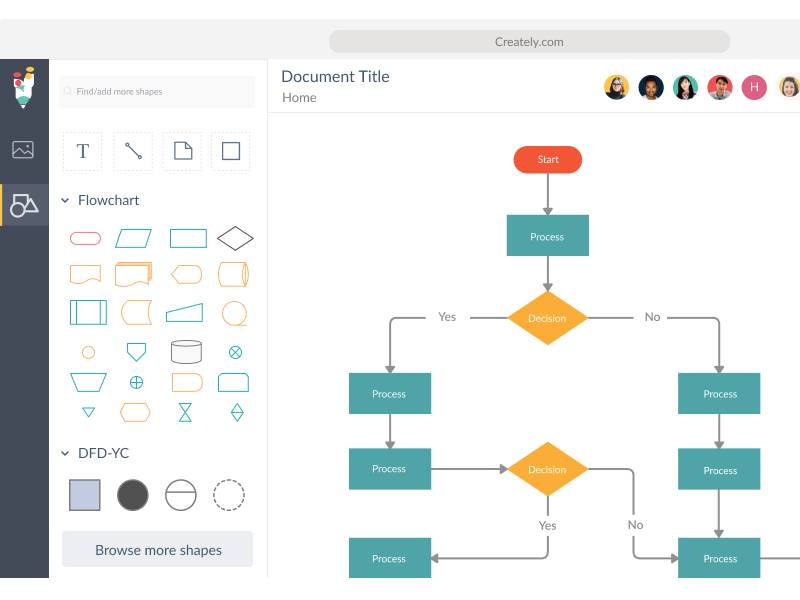Have you ever felt overwhelmed by the sheer number of tasks and responsibilities in your organization? If so, understanding business process flows could be the catalyst your team needs to achieve greater efficiency and clarity. In this comprehensive guide, we'll explore the fundamentals of business process flows, their benefits, and the critical steps to create one tailored to your business.
 The ABCs of Business Process Flows
The ABCs of Business Process Flows

 What are Business Process Flows?
What are Business Process Flows?
In the simplest terms, business process flows are visual representations of your company's processes, outlining each step and decision point along the way. They provide a clear roadmap for your team to follow, ensuring consistency, efficiency, and a shared understanding of each person's role within the process.
The Science Behind Business Process Flows
Business process flows stem from the broader concept of business process management (BPM), a systematic approach to optimize and manage an organization's processes. By focusing on BPM, companies can reduce costs, enhance customer satisfaction, and streamline their operations. Business process flows act as a practical tool to visualize and analyze these processes, making it easier to identify areas for improvement.
Benefits of Implementing Business Process Flows
Why should you invest time and effort in creating business process flows? Here are some compelling reasons:
- Improved efficiency: Streamlining your processes helps eliminate redundant steps and bottlenecks, allowing you to focus on what truly matters.
- Greater consistency: With a standardized process, you'll notice a significant reduction in errors and discrepancies, leading to more predictable outcomes.
- Enhanced communication: Visual aids make it easier for team members to understand their roles and responsibilities, fostering better collaboration.
- Simplified onboarding: New hires can quickly grasp the processes they need to follow, reducing their learning curve and improving their productivity from day one.
How Edworking Can Help

Edworking, an all-in-one productivity software, can assist you in creating, managing, and optimizing your business process flows. With its robust task management, file sharing, and workspace features, your team can collaborate seamlessly and stay on track with your business processes. Its integrated communication tools also make it easy to discuss and refine your processes without relying on external platforms.
 Building Your Business Process Flow
Building Your Business Process Flow

Step 1: Identify Your Goals and Objectives
Before you start creating your business process flow, it's crucial to have a clear understanding of your goals and objectives. What do you want to achieve with your process? Are you looking to streamline operations, improve customer satisfaction, or increase your bottom line? Identifying your desired outcomes will help you stay focused throughout the process and ensure your business process flow aligns with your organization's strategic objectives.
Step 2: Gather Relevant Information
Next, you need to collect all the necessary information about your process. Speak to stakeholders, team members, and subject matter experts to ensure you have a comprehensive understanding of the process at hand. Remember to consider any regulations, policies, or guidelines that may impact your process. Documenting this information will help you build a solid foundation for your business process flow.
Step 3: Map Out Your Process
With your goals and information in hand, it's time to create your business process flow. Start by outlining each step involved, from start to finish. You can use flowchart symbols, such as rectangles for tasks and diamonds for decision points, to create a visual representation of your process. Be sure to include any dependencies, decision points, and potential bottlenecks.
Pro Tip: Keep It Simple
While it's essential to capture all the necessary details, avoid overcomplicating your business process flow. A cluttered or convoluted flowchart will only confuse your team and hinder their progress. Strive for simplicity and clarity, ensuring that your process is easy to understand and follow.
Step 4: Validate and Refine Your Process

Once you've mapped out your process, it's vital to validate its accuracy. Consult with stakeholders and team members to ensure that your flowchart accurately represents the process. Be open to feedback and make any necessary adjustments. This iterative process will help you refine your business process flow and ensure its effectiveness.
Don't forget to assess your process's performance once it's implemented. Collect data on key performance indicators (KPIs) to measure the success of your process and identify areas for improvement. Regularly reviewing and updating your process will ensure it remains aligned with your organization's evolving needs.
Step 5: Implement and Monitor Your Process
Finally, it's time to put your business process flow into action. Communicate the new process to your team, provide any necessary training, and ensure everyone understands their role within the process. As your team begins to follow the process, closely monitor their progress and gather feedback.
Continuous Improvement Is Key
Remember that your business process flow is not set in stone. Regularly review and update your process to keep up with changing business needs, technology advancements, or new regulations. Embracing a culture of continuous improvement will help your business stay agile and competitive in today's fast-paced market.
 Tools and Techniques for Creating Business Process Flows
Tools and Techniques for Creating Business Process Flows
 Software Tools to Get You Started
Software Tools to Get You Started
In this digital age, a plethora of software tools can help you create and manage your business process flows. Some popular options include:
- Microsoft Visio: A powerful diagramming tool with extensive flowcharting capabilities and numerous templates to choose from.
- Lucidchart: A user-friendly, web-based diagramming software with real-time collaboration features, making it easy for teams to work together on process flows.
- draw.io: A free, open-source diagramming tool with a wide range of templates and integrations, perfect for those on a tight budget.

Process Mapping Techniques
In addition to software tools, you may want to explore various process mapping techniques to create your business process flow. Some popular techniques include:
- Flowcharts: The most common method, using symbols and arrows to represent tasks and the flow of the process.
- Swimlane Diagrams: These diagrams organize tasks by department or team member, clearly showing responsibilities and handoffs between different roles.
- Value Stream Mapping: A more advanced technique, focusing on the value-added steps in the process and eliminating waste to improve efficiency.
Best Practices for Effective Process Flows

To ensure your business process flows are effective and easy to follow, keep these best practices in mind:
- Be clear and concise: Use simple language and avoid jargon to ensure your process is accessible to everyone on your team.
- Use consistent formatting: Apply a consistent style to your flowchart, such as using the same colors and fonts, to create a cohesive and professional appearance.
- Involve your team: Encourage team members to provide input and feedback on the process, as they may have valuable insights to share.
 Conclusion: Streamline Your Business with Process Flows
Conclusion: Streamline Your Business with Process Flows
By now, you should have a solid grasp of the importance of business process flows and how to create one tailored to your organization. Implementing a well-structured process flow can lead to increased efficiency, consistency, and communication within your team. Remember to continuously improve and adapt your process flows to stay ahead in this fast-paced business world.
With tools like Edworking, managing your business process flows has never been easier. By consolidating essential features such as task management, file sharing, workspaces, and integrated communication tools into one platform, Edworking simplifies remote work management for small businesses and project managers. Its transparent work environment facilitated by the Stories feature further enhances collaboration, ensuring your team stays on track with your business processes.
Embrace the transformative power of streamlined processes today by incorporating business process flows into your organization. Not only will you reap the benefits of increased productivity and reduced reliance on multiple software applications, but you'll also foster a more cohesive and collaborative work environment for your team. So, why wait? Get started on your journey to optimized business processes and let Edworking help you every step of the way.





